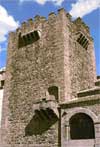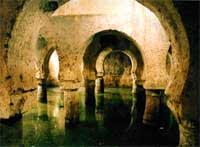
Cáceres information
Monuments
Caceres, capital of the northern province of Extremadura, is located
in an area which for centuries and millenniums has been inhabited
by different peoples and cultures from pre-historic times to the
present. In the Maltravieso Cave, paintings have been found belonging
 to
the Palaeolithic era, over 20,000 years old.
to
the Palaeolithic era, over 20,000 years old.
Two periods in it development have left their mark on today's
monumental city: the Arab stronghold before it fell to the Christians
in 1229, and the feudal city between the 14th and 16th C, when
it was filled with palaces and towers of aristocratic families.
This ancient urban complex full of its own personality was named
a United Nations "World Heritage" city in 1986 or "Patrimonio
de Humanidad".
The Almohade turned Cáceres into a stronghold and added
a series of towers to the defensive system. Five rectangular towers
still stand on the western side of the curtain walls, among them
the famous Bujaco tower. In the south, there are two polygonal
towers: Redonda and Desmochada; and in the east, the Tower of
Los Pozos rises 30m above the ring road and is partly integrated
in the battlements.
 Medieval
life in Cáceres was right out of the pages of a Shakespearean
drama like Romeo and Juliet, with rival families similar to the
Montagues and Capulets fighting each other in the streets from
the safety of fortified palaces and towers. Feud
Medieval
life in Cáceres was right out of the pages of a Shakespearean
drama like Romeo and Juliet, with rival families similar to the
Montagues and Capulets fighting each other in the streets from
the safety of fortified palaces and towers. Feud s
between the private armies of noble families often divided Cáceres
in to warring factions. Examples of this feudal period were towers
built not along the city wall to defend against foreign attackers,
but towers erected inside the city to defend against hostile neighbors.
s
between the private armies of noble families often divided Cáceres
in to warring factions. Examples of this feudal period were towers
built not along the city wall to defend against foreign attackers,
but towers erected inside the city to defend against hostile neighbors.
Churches and convents were also built, such as the Gothic Church
of Santa María, which has cathedral status, Santiago, and
San Mateo, which was built in the 14th C on the site of a mosque,
and the Gothic Convent of San Francisco.
Roman City
Cáceres, known in Roman times as Norba Caesarina, still
maintains some walls built when it was founded in 29 B.C. Also
remains of the Roman military outpost camps such as the Castra
Caecilia known as Cáceres “El Viejo” can still
be found near modern Cáceres.
Arab City
However, the greatest historical and artistic heritage of Cáceres
began in the Middle Ages: with the arrival of the Arab culture
and the Almoravid domination, Cáceres was known by the
name of Hizn Qazris. The ”Almohade” people rebuilt
the city walls and Cáceres regained its strategic importance.
Inside the city, the most important Muslim monument is a water
storage facility or "aljibe" divided into five parts
with Arab horseshoe arches. This is the best example of an aljibe
outside of the Muslem world today. The layout of the city streets
and twisting alleys leading into small squares is the most important
legacy of the Almohad period.


